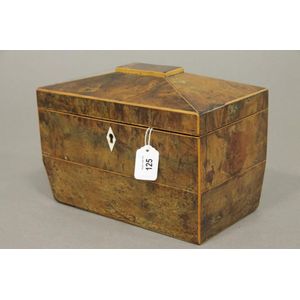Victorian Burr Walnut Tea Caddy with Boxwood Stringing
An early Victorian burr walnut tea caddy with boxwood stringing between all panels. Two lidded compartments with bone knobs. Side handles removed. Length 19 cm
You must be a subscriber, and be logged in to view price and dealer details.
Subscribe Now to view actual auction price for this item
When you subscribe, you have the option of setting the currency in which to display prices to $Au, $US, $NZ or Stg.
This item has been sold, and the description, image and price are for reference purposes only.
- Burr - Burr (or in the USA, burl) is the timber from the knotted roots or deformed branch of the tree, which when cut, displays the small circular knots in various gradations of colour. It is always cut into a decorative veneer, most commonly seen as burr walnut on 19th century furniture.
- Boxwood - Boxwood is a hard, yellow coloured, close grained timber. In the 19th century it was often used for inlays, especially stringing, because of its contrasting colour to the darker timbers of the carcase. Stringing is the inlay of a narrow strip of veneer of a lighter colour, such as boxwood along or close to the edges of an object that has been veneered in a darker timber such as mahogany.
Because of its fine grain and resistnce to splitting or chipping it has also been used for treen, turnings, carvings and other small wooden items, such as chess pieces. - Victorian Period - The Victorian period of furniture and decorative arts design covers the reign of Queen Victoria from 1837 to 1901. There was not one dominant style of furniture in the Victorian period. Designers used and modified many historical styles such as Gothic, Tudor, Elizabethan, English Rococo, Neoclassical and others, although use of some styles, such as English Rococo and Gothic tended to dominate the furniture manufacture of the period.
The Victorian period was preceded by the Regency and William IV periods, and followed by the Edwardian period, named for Edward VII (1841 ? 1910) who was King of the United Kingdom and the British Dominions and Emperor of India for the brief period from 1901 until his death in 1910.
This item has been included into following indexes:
-
tea caddies, material
- other materials 140
- walnut 63
- tea caddies, period or age - Victorian 189
Visually similar items

A Georgian walnut tea caddy, 13 cm high, 21 cm wide, 12 cm deep
Sold by
in
for
You can display prices in $Au, $US, $NZ or Stg.

Antique English writing slope, with brass inlay, approx 15 cm high, 40 cm wide, 24 cm deep
Sold by
in
for
You can display prices in $Au, $US, $NZ or Stg.

Late 19th century Oriental tea caddy
Sold by
in
for
You can display prices in $Au, $US, $NZ or Stg.

A decorative Chinese box. Height 18 cm. Width 390 Depth 20.5 cm
Sold by
in
for
You can display prices in $Au, $US, $NZ or Stg.
